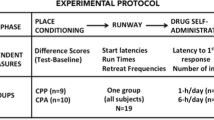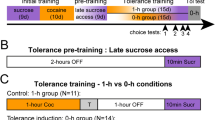Abstract
Three experiments were conducted to compare the effectiveness of intraperitoneally (IP) administered or subcutaneously (SC) administered cocaine to produce place and/or taste conditioning after four conditioning trials. In each experiment, IP (5–20 mg/kg) cocaine produced a place preference, but SC (0.5–20 mg/kg) cocaine at concentrations that prevented necrosis, did not produce a place preference. The failure of SC cocaine to produce a place preference was not a function of conditioning trial duration. On the other hand, SC cocaine (20 mg/kg) produced conditioned taste avoidance, but IP cocaine (20 mg/kg) did not produce conditioned taste avoidance. The results suggest that IP cocaine, but not SC cocaine, is rewarding.
Similar content being viewed by others
References
Bardo MT, Neisewander JL, Pierce RC (1990) Novelty-induced place preference behavior in rats: effects of opiate and dopaminergic drugs. Pharmacol Biochem Behav 32:683–687
Bardo MT, Neisewander JL, Miller JS (1986) Repeated testing attenuates conditioned place preference with cocaine. Psychopharmacology 89:239–243
Benuck M, Lajtha A, Reith MEA (1987) Pharmacokinetics of systemically administered cocaine and locomotor stimulation in mice. J Pharmacol Exp Ther 243:144–149
Booth DA, Pilcher GD, D'Mello GD, Stolerman IP (1977) Comparative potencies of amphetamine, fenfluramine and related compounds in taste aversion experiments in rats. Br J Pharmacol 61:669–677
Cappell H, LeBlanc AE (1975) Conditioned aversion by psychoactive drugs: does it have significance for an understanding of drug dependence? Addict Behav 1:55–64
Costello NL, Carlson JN, Glick SD, Bryda M (1989) Dose-dependent and baseline-dependent conditioning withd-amphetamine in the place conditioning paradigm. Psychopharmacology 99:244–247
deWit H, Bodker B, Ambre J (1992) Rate of increase of plasma drug level influences subjective response in humans. Psychopharmacology 107:352–358
Ferrari CM, O'Connor DA, Riley AL (1991) Cocaine-induced taste aversions: effect of route of administration. Pharmacol Biochem Behav 38:267–271
Foltin RW, Schuster CR (1982) The effects of cocaine in a gustatory avoidance paradigm: a procedural analysis. Pharmacol Biochem Behav 16:347–352
Foltin RW, Preston KL, Wagner GC, Schuster CR (1981) The aversive stimulus properties of repeated infusions of cocaine. Pharmacol Biochem Behav 15:71–74
Goudie AJ, Dickins DW, Thornton EW (1977) Cocaine-induced conditioned taste aversion in rats. Pharmacol Biochem Behav 8:757–761
Houdi AA, Bardo MT, Van Loon GR (1989) Opioid mediation of cocaine-induced hyperactivity and reinforcement. Brain Res 497:195–198
Hunt T, Amit Z (1987) Conditioned taste aversion induced by self-administered drugs: Paradox revisited. Neurosci Biobehav Rev 11:107–130
Issac WL, Nonneman AJ, Neisewander J, Landers T, Bardo MT (1989) Prefrontal cortex lesions differentially disrupt cocaine-reinforced conditioned place preference but not conditioned taste aversion. Behav Neurosci 103:345–355
Lawley SI, Kantak KM (1990) Post-conditioning effects of magnesium on cocaine conditioned place preference in mice. Pharmacol Biochem Behav 36:531–538
Morency MA, Beninger RJ (1986) Dopaminergic substrates of cocaine-induced place conditioning. Brain Res 399:33–41
Nayak PK, Misra AL, Mule SJ (1976) Physiological disposition and biotransformation of [3H] cocaine in acutely and chronically treated rats. J Pharmacol Exp Ther 196:556–569
Nomikos GG, Spyraki C (1988) Cocaine-induced place conditioning: Importance of route of administration and other variables. Psychopharmacology 94:119–125
Parker LA (1992) Place conditioning in a three or four choice apparatus: role of stimulus novelty in drug-induced place conditioning. Behav Neurosci 106:1–13
Parker LA (1993) Taste reactivity responses elicited by cocaine-paired, phencyclidine-paired, and methamphetamine-paired sucrose solutions. Behav Neurosci 107:118–129
Reicher MA, Holman EW (1977) Location preference and flavour aversion reinforced by amphetamine in rats. Anim Learn Behav 5:343–346
Scoles MT, Siegel S (1986) A potential role of saline trials in morphine-induced place preference conditioning. Pharmacol Biochem Behav 35:583–587
Spyraki C, Fibiger HC, Phillips AG (1982) Cocaine-induced place preference conditioning: lack of effects of neuroleptics and 6-hydroxydopamine lesions. Brain Res 253:195–203
Van Haaren F, Hughes CE (1990) Cocaine-induced conditioned taste aversions in male and female wistar rats. Pharmacol Biochem Behav 37:693–696
Wise RA, Yokel P, Dewitt H (1976) Both positive reinforcement and conditioned aversion from amphetamine and from apomorphine in rats. Science 191:1273–1274
Yeh SY, Haertzen CA (1991) Cocaine-induced locomotor activity in rats. Pharmacol Biochem Behav 39:723–727
Author information
Authors and Affiliations
Rights and permissions
About this article
Cite this article
Mayer, L.A., Parker, L.A. Rewarding and aversive properties of IP and SC cocaine: assessment by place and taste conditioning. Psychopharmacology 112, 189–194 (1993). https://doi.org/10.1007/BF02244909
Received:
Revised:
Issue Date:
DOI: https://doi.org/10.1007/BF02244909




